Kingdaflex offers hydraulic hoses that adhere to SAE standards, ensuring top-tier quality and performance. Our hydraulic hoses meet or exceed SAE specifications, guaranteeing compatibility and reliability in demanding hydraulic systems. We provide a broad range of SAE-compliant hoses, designed for various pressure and temperature applications, ensuring your operations run smoothly and safely.

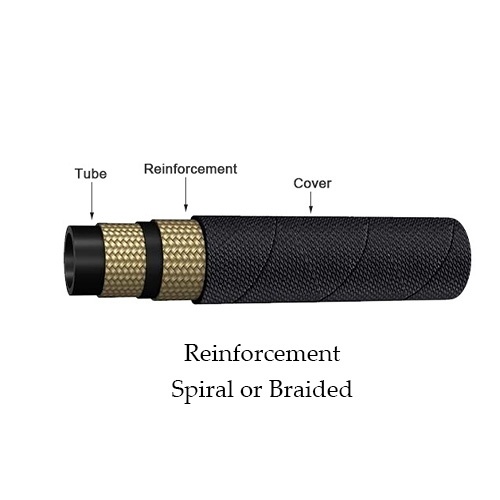
A hydraulic hose is designed with 3 layers, inner tube, reinforcement layer, and outer cover.
Inner Tube: Oil-resistant synthetic rubber inner tube
Reinforcement: Braided or spiral reinforcement, made of steel wire or textile
Outer Cover: Oil and weather-resistant synthetic rubber outer cover.
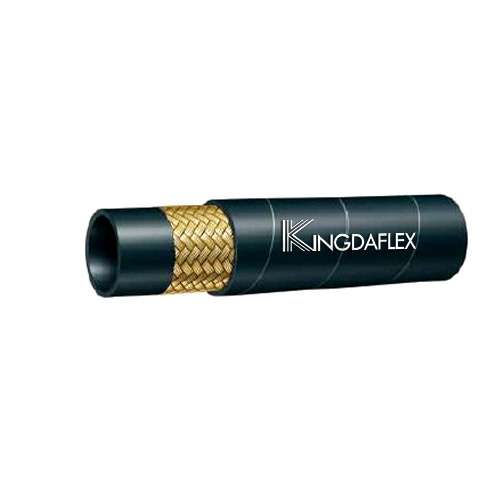
Type A:
Inner Tube: Oil-resistant synthetic rubber inner tube
Reinforcement: Single layer braided wire reinforcement, is made of one layer of braided steel wire, with high strength.
Outer Cover: Oil and weather-resistant synthetic rubber outer cover.
Here is a layer of adhesive rubber material between the reinforced steel wire and inner tube & outer cover, to add strength and stability to the whole hydraulic hose.
Type AT: The structure of this hydraulic hose is the same as the Type A SAE 100R1 hydraulic hose, but without needing to skive the cover when assembling, because of the special size of the outer cover design.
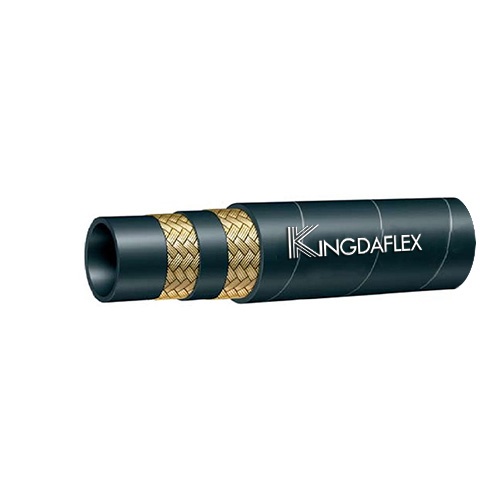
Type A:
Inner Tube: Oil resistant synthetic rubber inner tube
Reinforcement: Double layers of braided steel wire reinforcement
Outer Cover: Oil and weather resistant synthetic rubber outer cover.
Here is a layer of adhesive rubber material between the reinforced steel wire and inner tube & outer cover, to add strength and stability to the whole hydraulic hose.
Type AT: The structure of this hydraulic hose is the same as the Type A SAE 100R2 hydraulic hose, but without needing to skive the cover when assembling, because of the special size of the outer cover design.
The big difference between SAE 100R1 and SAE 100R2 is the layer of the steel wire reinforcement, and SAE 100R2 is structured with 2-wire braided steel wire reinforcement, so it can be much stronger.
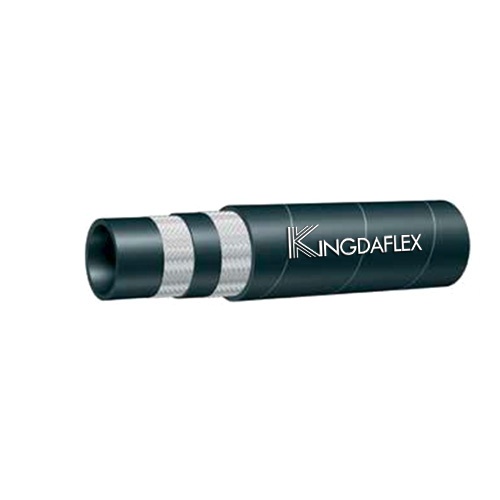
The structure of the SAE 100R3 hydraulic hose is that:
Inner Tube: Oil resistant synthetic rubber tube
Reinforcement: 2 layers of fabric as the reinforcement, the reinforcement is made of cotton fabric textile, and the textile reinforcement is much softer than braided steel wire reinforcement.
Outer Cover: Oil and weather resistant synthetic rubber outer cover.
SAE 100R3 hydraulic hose can be applied for the Petroleum-based hydraulic oil and water hydraulic hose system with lower pressure.
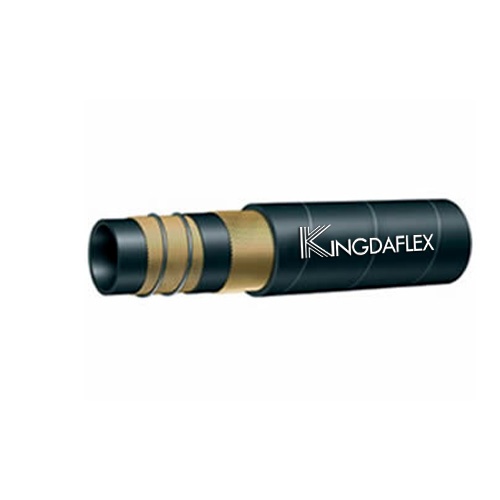
Structure:
Inner Tube: This hydraulic hose structure is: an oil-resistant synthetic rubber inner tube layer
Reinforcement: A fabric textile braided reinforcement layer, add a steel wire spiral layer as the reinforcement
Outer Cover: Oil and weather resistant synthetic rubber outer layer as the cover.
Application: SAE 100R4 is mainly used in petroleum-based hydraulic oil and water systems, and can be used in low pressure and suction lines for the hydraulic systems.
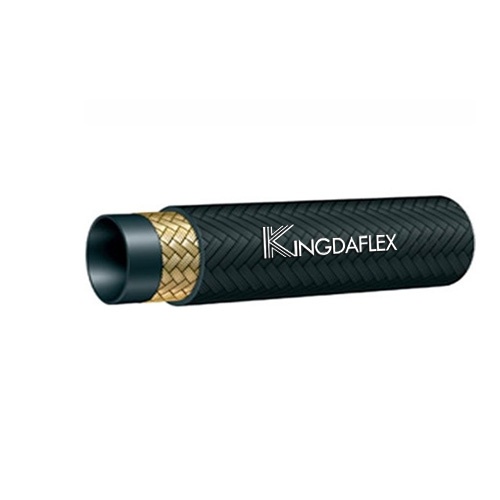
Structure: SAE 100R5 hydraulic hose is designed with 1-wire reinforcement
Inner tube: Oil-resistant synthetic rubber inner tube
Reinforcement: A fabric textile braided reinforcement layer, add a high-strength braided steel wire layer to combine reinforcement layer
Outer cover: fabric textile braided layer as the outer cover
All steel wires and cotton textile threads are treated with oil and mildew resistance.
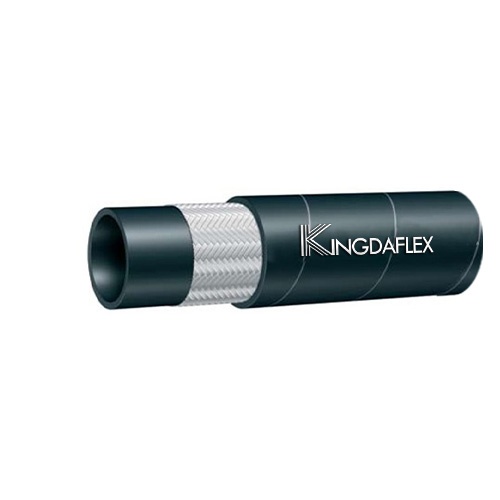
Structure: SAE 100R6 hydraulic hose is designed with 1-wire reinforcement
Inner tube: Oil-resistant synthetic rubber inner tube
Reinforcement: A fabric textile braided reinforcement layer
Outer cover: Oil and weather resistant synthetic rubber outer layer as the cover
SAE 100R6 hydraulic hose is mainly applied for gasoline, diesel, lubricating oil, air and water hydraulic systems.

Structure: SAE 100R7 is the thermoplastic hydraulic hose
Inner tube: Oil-resistant thermoplastic inner tube
Reinforcement: A fabric textile braided reinforcement layer
Outer cover: Oil and weather-resistant thermoplastic outer layer
SAE 100R7 thermoplastic hose tube is assembled with the special fittings, you can’t connect it with other hydraulic hose fittings.

Structure: SAE 100R8 is the thermoplastic hydraulic hose applied under high pressure
Inner tube: Oil-resistant thermoplastic inner tube
Reinforcement: Two layers of fabric textile braided reinforcement, so this thermoplastic hose can work for the hydraulic systems with high pressure.
Outer cover: Oil and weather-resistant thermoplastic outer layer
SAE 100R8 thermoplastic hose tube is assembled with the special fittings, you can’t connect it with other hydraulic hose fittings.
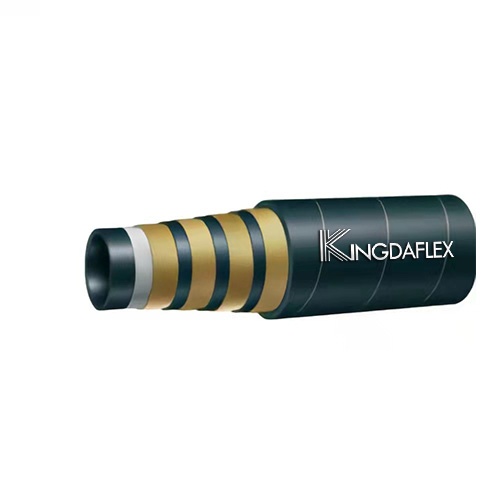
Type A: Structure: SAE 100R9 is the 4-wire spiral hydraulic hose
Inner tube: Oil-resistant synthetic rubber inner tube
Reinforcement: Four layers of steel wire spiral reinforcement, with high strength, so this spiral hydraulic hose can work for the hydraulic systems under high pressure.
Outer cover: Oil and weather-resistant synthetic rubber outer layer
Here is a layer of adhesive synthetic rubber material added to the space between the steel wire reinforcement layer and the inner tube and outer cover, to ensure the stability of the whole hydraulic hose.
Type AT: The same as Type A, without needing to skive the cover when assembling, because it is the no skive hydraulic hose.

Structure: SAE 100R12 is the high pulse hydraulic hose
Inner tube: Oil-resistant synthetic rubber inner tube
Reinforcement: Four layers of heavy type steel wire spiral reinforcement, with high strength, so this spiral hydraulic hose can work for the hydraulic systems under high pressure.
Outer cover: Oil and weather-resistant synthetic rubber outer layer
Here is a layer of adhesive synthetic rubber material added to the space between the steel wire reinforcement layer and the inner tube and outer cover, to ensure the stability of the whole hydraulic hose.
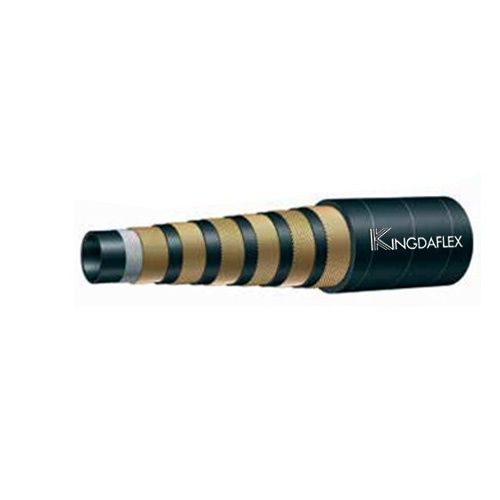
Structure: SAE 100R13 is the 6 wire spiral hydraulic hose
Inner tube: Oil-resistant synthetic rubber inner tube
Reinforcement: Six layers of heavy type steel wire spiral reinforcement, with high strength
Outer cover: Oil and weather-resistant synthetic rubber outer layer
Here is a layer of adhesive synthetic rubber material added to the space between the steel wire reinforcement layer and the inner tube and outer cover, to ensure the stability of the whole hydraulic hose.

Structure: SAE 100R14 doesn’t have the steel wire reinforcement
Type A-
Inner tube: PTFE inner tube
Outer cover: 304 stainless steel braided cover
Type AT- structure is same as Type A- hydraulic hose, and inner tube is made of conductive material, no additional anti-static switch is needed. Welcome to quote stainless steel braided hydraulic hose now.

Structure: SAE 100R15 is similar to SAE 100R13
Inner tube: Oil-resistant synthetic rubber inner tube
Reinforcement: Six or more layers of heavy type steel wire spiral reinforcement, with high strength
Outer cover: Oil and weather-resistant synthetic rubber outer layer
Here is a layer of adhesive synthetic rubber material added to the space between the steel wire reinforcement layer and the inner tube and outer cover, to ensure the stability of the whole hydraulic hose.

Structure: SAE 100R16 is braided hydraulic hose
Inner tube: Oil-resistant synthetic rubber inner tube
Reinforcement: One or two layers of braided steel wire reinforcement, with high strength
Outer cover: Oil and weather-resistant synthetic rubber outer layer
Here is a layer of adhesive synthetic rubber material added to the space between the steel wire reinforcement layer and the inner tube and outer cover, to ensure the stability of the whole hydraulic hose.
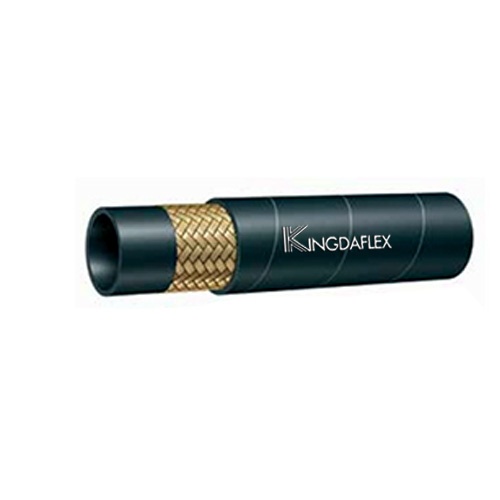
Structure: SAE 100R17 is braided hydraulic hose
Inner tube: Oil-resistant synthetic rubber inner tube
Reinforcement: One or two layers of braided steel wire reinforcement, with high strength
Outer cover: Oil and weather-resistant synthetic rubber outer layer
Here is a layer of adhesive synthetic rubber material added to the space between the steel wire reinforcement layer and the inner tube and outer cover, to ensure the stability of the whole hydraulic hose.
SAE 100R17 has smaller bend radius, constant working pressure of 21MPa
SAE International, formerly known as the Society of Automotive Engineers, is a globally recognized standards development organization.
It publishes technical standards for a wide range of engineering industries, including automotive, aerospace, and commercial vehicles. These standards are developed through the consensus of industry experts, ensuring they reflect best practices and current technologies. SAE standards are essential for ensuring compatibility, quality, and safety in engineering applications.
In the industry of hydraulic hoses, SAE standards define the specifications for hose construction, dimensions, pressure ratings, and performance requirements. These standards provide manufacturers and users with a common language and set of guidelines, facilitating the selection and application of hydraulic hoses. Adhering to SAE standards ensures that hydraulic systems operate reliably and safely, reducing the risk of failures and minimizing downtime.
The standards for hydraulic hoses are primarily set by SAE International (Society of Automotive Engineers) and ISO (International Organization for Standardization). These organizations develop and publish comprehensive guidelines that ensure hydraulic hoses meet specific performance and safety requirements. Adhering to these standards is crucial for manufacturers and users to guarantee compatibility, reliability, and longevity in hydraulic systems. The standards cover various aspects, including material composition, dimensional accuracy, pressure ratings, and testing procedures.
Here are the key standards that define the requirements for hydraulic hoses:
SAE J517 – Hydraulic Hose:
This standard provides detailed specifications for hydraulic hoses, encompassing dimensions, pressure ratings, and performance criteria. It covers various hose types, including wire braid and spiral wire reinforced hoses, ensuring they meet the essential standards for use in diverse hydraulic applications. Adherence to SAE J517 guarantees that hoses are manufactured to a consistent quality, providing reliable and safe operation in demanding environments. This standard also facilitates interchangeability between hoses from different manufacturers, as long as they all meet the SAE J517 requirements.
ISO 18752 – Rubber hoses and hose assemblies—Wire- or textile-reinforced hydraulic types—Specification:
This ISO standard specifies requirements for rubber hoses and hose assemblies used in hydraulic applications, covering wire or textile reinforcement. It defines performance criteria, dimensions, and testing procedures to ensure hoses can withstand the pressures and conditions of hydraulic systems. ISO 18752 aims to harmonize global standards, enabling international trade and ensuring consistent quality across different regions. This standard also emphasizes the importance of proper selection and installation to maintain system integrity and prevent failures.
ISO 3862 – Rubber hoses and hose assemblies—Rubber-covered, spiral-wire-reinforced, hydraulic type—Specification:
This ISO standard focuses on rubber-covered, spiral-wire-reinforced hydraulic hoses and hose assemblies. It sets out the specifications for these hoses, including dimensions, pressure ratings, and performance requirements, ensuring they meet the demanding needs of high-pressure hydraulic applications. These hoses are commonly used in heavy machinery and industrial settings, where robust and reliable performance is essential. This standard provides guidelines for both the hose construction and the testing procedures to validate their performance.
Hydraulic hose SAE standards are crucial for ensuring the quality, compatibility, and safety of hydraulic systems. SAE International publishes these standards, which define the specifications for hydraulic hoses used in various industries. Adherence to these standards guarantees that hoses meet specific performance criteria, including pressure ratings, temperature resistance, and dimensional accuracy. By following these guidelines, manufacturers and users can ensure reliable and consistent performance in demanding hydraulic applications.
These standards cover a wide range of hydraulic hose types and applications, providing detailed specifications for construction, materials, and testing procedures. Understanding and complying with SAE standards is essential for selecting and using hydraulic hoses that meet the specific requirements of a given system. This ensures optimal performance, minimizes the risk of failures, and maximizes the lifespan of hydraulic components.
SAE J517 – Hydraulic Hose
This standard outlines the general specifications for hydraulic hoses, including dimensions, pressure ratings, and performance requirements. It covers various hose types, such as wire braid and spiral wire reinforced hoses, ensuring they meet the necessary standards for use in hydraulic systems. Adherence to J517 ensures hoses are reliable and safe for their intended applications, providing consistent performance and longevity.
SAE J343 – Tests and Procedures for SAE 100R Series Hydraulic Hose and Hose Assemblies:
This standard details the testing procedures for SAE 100R series hydraulic hoses and hose assemblies, including impulse testing, burst testing, and leakage testing. These tests ensure that hoses can withstand the pressures and conditions they are designed for, validating their performance and reliability. Following these procedures guarantees that hydraulic systems operate safely and efficiently under various operational stresses.
SAE J516 – Hydraulic Hose Fittings:
This standard specifies the dimensions and performance requirements for hydraulic hose fittings, ensuring compatibility with SAE hydraulic hoses. It covers various fitting types, including threaded and flange connections, providing guidelines for proper assembly and installation. Compliance with J516 ensures leak-free connections and optimal performance in hydraulic systems, minimizing downtime and maintenance.
SAE J1942 – High Pressure Hydraulic Hose Assemblies for Marine Applications:
This standard provides specific requirements for high-pressure hydraulic hose assemblies used in marine applications, considering the harsh environmental conditions and safety requirements of marine environments. It addresses factors like corrosion resistance and durability, ensuring hoses can withstand saltwater exposure and extreme temperatures. Adherence to J1942 guarantees reliable and safe operation in marine hydraulic systems.
SAE hydraulic hose standards are integral to ensuring the reliability and safety of hydraulic systems across diverse industries. These standards define the performance and construction requirements for hydraulic hoses, guaranteeing they meet specific pressure, temperature, and dimensional specifications. Understanding the applications of SAE-compliant hoses is crucial for selecting the right hose for each unique hydraulic system, optimizing performance and minimizing risks.
SAE-compliant hydraulic hoses find application in a wide range of industries, each with specific demands and requirements. Adhering to SAE standards ensures compatibility and safety, crucial for the efficient operation of complex hydraulic systems. The versatility and reliability of these hoses make them indispensable in various sectors.
Construction and Heavy Machinery:
SAE-compliant hoses are vital in construction equipment like excavators, bulldozers, and cranes, where high-pressure hydraulic systems are essential for lifting, digging, and moving heavy loads. These hoses withstand harsh conditions, including extreme temperatures and abrasive environments, ensuring reliable operation and preventing costly downtime.
Agriculture:
In agriculture, SAE hydraulic hoses are used in tractors, harvesters, and other farm machinery to power hydraulic systems for tasks like lifting, steering, and implement control. These hoses provide the necessary durability and pressure resistance to handle demanding agricultural operations, ensuring efficient and reliable performance in the field.
Automotive and Transportation:
SAE hydraulic hoses are used in automotive manufacturing and transportation for applications like power steering, braking systems, and hydraulic lifts. They provide the necessary flexibility and pressure resistance to ensure safe and efficient operation of vehicles and transportation equipment.
Manufacturing and Industrial Equipment:
In manufacturing and industrial settings, SAE hydraulic hoses are used in hydraulic presses, injection molding machines, and other industrial equipment. They provide the necessary pressure and temperature resistance to handle demanding manufacturing processes, ensuring consistent and reliable operation.
Marine and Offshore:
SAE hydraulic hoses are used in marine applications like ship hydraulic systems, offshore drilling platforms, and underwater equipment. They are designed to withstand harsh marine environments, including saltwater exposure and extreme pressures, ensuring reliable operation in demanding offshore applications.
Regular inspection of hydraulic hoses is crucial for preventing system failures and ensuring safety. Hydraulic hoses are subjected to high pressures and harsh conditions, which can lead to wear and tear over time. A thorough inspection can identify potential issues before they escalate, minimizing downtime and preventing accidents. We will guide you through the key steps for a comprehensive hydraulic hose inspection.
Step 1: Visual Inspection
Begin with a visual inspection of the entire hose assembly. Look for any signs of external damage, such as cuts, abrasions, cracks, or bulges. Pay close attention to areas where the hose connects to fittings, as these points are prone to wear and leaks. Check for any signs of corrosion or rust on metal components. A thorough visual inspection helps identify obvious signs of damage, allowing for prompt action.
Next, examine the hose’s outer cover for any signs of deterioration, such as hardening, softening, or discoloration. These changes can indicate that the hose is nearing the end of its lifespan or has been exposed to incompatible fluids or extreme temperatures. Also, look for any signs of twisting, kinking, or flattening of the hose, as these can restrict fluid flow and increase pressure.
Step 2: Functional Inspection
After the visual inspection, conduct a functional inspection by operating the hydraulic system at its normal operating pressure. Listen for any unusual noises, such as hissing or popping, which could indicate leaks or hose damage. Observe the hose for any signs of movement or vibration, which could suggest loose fittings or inadequate clamping. A functional inspection helps identify issues that may not be apparent during a static visual check.
Check for any signs of leakage at the hose connections and along the hose’s length. Use a piece of cardboard or paper to detect leaks, as they may not always be visible. Carefully run the cardboard along the hose and fittings, looking for any wet spots. Also, monitor the system’s performance for any signs of reduced efficiency or increased cycle times, which could indicate internal hose damage or blockage.
SAE 100R7 and SAE 100R8 are both thermoplastic hydraulic hoses designed for medium to high-pressure hydraulic applications, but they differ significantly in their construction and performance characteristics. The primary distinction lies in their reinforcement materials and pressure ratings. 100R7 hoses typically use synthetic fiber braiding as reinforcement, while 100R8 hoses utilize aramid fiber, which offers higher tensile strength and pressure resistance. This difference in reinforcement directly impacts the hose’s working pressure and overall durability.
Here are the key differences between these two hydraulic hose types:
Reinforcement Material:
SAE 100R7: Uses synthetic fiber braiding, which provides good flexibility and moderate pressure resistance.
SAE 100R8: Uses aramid fiber braiding, offering superior tensile strength and higher pressure ratings.
Pressure Rating:
SAE 100R8 hoses generally have higher working pressure ratings compared to 100R7 hoses, making them suitable for more demanding hydraulic applications.
Flexibility:
SAE 100R7 hoses tend to be more flexible due to their synthetic fiber reinforcement, which can be advantageous in applications requiring tight bends.
SAE 100R8 hose, while still flexible, can be slightly less so due to the aramid fiber reinforcement.
Applications:
SAE 100R7: Commonly used in medium-pressure hydraulic systems, such as those found in mobile equipment and general industrial applications.
SAE 100R8: Preferred for high-pressure hydraulic systems, including those in construction equipment, aerial lifts, and other heavy-duty applications.
SAE 100R16 and SAE 100R17 are both wire-braided hydraulic hoses designed for medium-high pressure applications, but they differ in their construction and intended use, particularly regarding flexibility and bend radius. The primary distinction lies in their design to address different space constraints and flexibility requirements in hydraulic systems.
Here’s a breakdown of the key differences between these two hydraulic hose types:
Flexibility and Bend Radius:
SAE 100R16: Designed for applications requiring a tighter bend radius, offering greater flexibility in confined spaces. This makes it ideal for installations with limited space and complex routing.
SAE 100R17: Specifically engineered for even greater flexibility and a significantly reduced bend radius compared to standard wire-braided hoses, including 100R16. This provides enhanced maneuverability and easier installation in extremely tight spaces.
Construction and Size:
SAE 100R17 often has a more compact design, resulting in a smaller outer diameter compared to traditional hoses like SAE 100R16. This compact nature contributes to its enhanced flexibility and easier routing.
both hoses use wire reinforcement, how ever there are slight changes in construction to allow the R17 too have a tighter bend radius.
Applications:
SAE 100R16: Suitable for general medium-high pressure hydraulic applications where flexibility is important, but space constraints are not extreme.
SAE 100R17: Ideal for applications with very tight routing requirements and where a highly flexible hose is essential, such as in certain mobile hydraulic systems or compact machinery.
SAE J1960 and SAE J2527 are both standards that pertain to hydraulic hose assemblies, but they differ significantly in their scope and focus. SAE J1960 specifically deals with the testing of high-pressure hydraulic hose assemblies used in automotive power steering systems. In contrast, SAE J2527 is focused on the testing of hose assemblies under more general hydraulic fluid applications, and the environmental degredation of materials. Therefore they are covering differant materials, and testing situations.
Specifically SAE J1960 provides tests to mesure and insure the hose assemblies can withstand the vigorous demands of power steering, where pressure and temperature fluctuations are constant. Where SAE J2527 is concerned about hose use under different temperatures, and exposure conditions.
In a practical sense, you could say that SAE J1960 is dealing with a very specific situation within automotive use, and SAE J2527 has a far wider range of application conditions that it accounts for within its testing parameters.